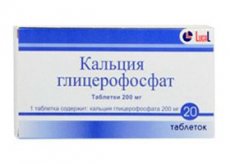Medical expert of the article
New publications
Preparations
Calcium glycerophosphate
Last reviewed: 03.07.2025

All iLive content is medically reviewed or fact checked to ensure as much factual accuracy as possible.
We have strict sourcing guidelines and only link to reputable media sites, academic research institutions and, whenever possible, medically peer reviewed studies. Note that the numbers in parentheses ([1], [2], etc.) are clickable links to these studies.
If you feel that any of our content is inaccurate, out-of-date, or otherwise questionable, please select it and press Ctrl + Enter.

Calcium is a key chemical element involved in the biochemical and physiological processes of a living organism. It is involved in the mechanism of blood clotting, muscle contraction, serves as a vehicle for delivering various substances to cell membranes that are necessary for processes occurring in the cell, in particular the synthesis of hormones and neurotransmitters. The need for this macronutrient is different at each age. The greatest is in adolescence (1.3 g per day), since intensive skeletal growth requires more "building material". Calcium enters the body with food: milk, cottage cheese, legumes, nuts, vegetables, there is a lot of it in poppy and sesame. A deficiency of the substance affects the state of health and appearance: irritability, nervousness, fatigue appear, the skin becomes withered, hair is dull and brittle, muscle spasms appear, and sometimes they tremble. The most dangerous is the development of rickets in children and osteoporosis in adults. Calcium glycerophosphate is a remedy for calcium deficiency.
Pharmacodynamics
Calcium glycerophosphate normalizes calcium-phosphorus metabolism, stimulates the process of protein synthesis, and replenishes the mineral deficiency in the body. The pharmacodynamics of the drug is due to the ability of calcium ions to participate in various metabolic processes, which is necessary to maintain the functioning of the cardiac myocardium, in the processes of blood clotting, and the formation of bone tissue.
 [ 9 ]
[ 9 ]
Pharmacokinetics
The pharmacokinetics of the drug are as follows: calcium absorption occurs mainly in the duodenum, since there is the highest concentration of calcitriol - a hormone whose biological role in the body is to promote the absorption of calcium and phosphate. This is precisely why there is a subtle mechanism for regulating its production. Lactose also promotes absorption, and a number of fats interfere: cow's milk, beef, palm oil. This natural regulation scheme maintains the content of the substance in the body in balance. It is excreted mainly through the intestines (80%), the rest - through the kidneys.
Dosing and administration
Use Calcium glycerophosphate during pregnancy
Use during pregnancy is not contraindicated. During lactation, if the child is prescribed calcium or vitamin D3 preparations, the nursing woman should refrain from taking calcium glycerophosphate, otherwise it will lead to an overdose.
Contraindications
Contraindications to the use of the drug exist for people with excess calcium in the blood and urine, allergies to any of its components, serious kidney dysfunction, increased blood clotting, atherosclerosis. Not prescribed to children under 3 years of age.
 [ 13 ]
[ 13 ]
Side effects Calcium glycerophosphate
The development of allergies, hypercalcemia and calciuria are possible side effects of calcium glycerophosphate. Nausea, abdominal pain, and disturbances in the defecation system may also occur.
 [ 14 ]
[ 14 ]
Overdose
Interactions with other drugs
Simultaneous administration of calcium preparations enhances the effect of tetracycline antibiotics and cardiac glycosides - cardiological agents based on plants: foxglove (digitoxin, digoxin), lily of the valley (corglycon), adonis (tincture). Combined use with glucocorticosteroids, loop diuretics reduces the content of the substance in the body, but thiazide diuretics can lead to hypercalcemia.
 [ 23 ]
[ 23 ]
Attention!
To simplify the perception of information, this instruction for use of the drug "Calcium glycerophosphate" translated and presented in a special form on the basis of the official instructions for medical use of the drug. Before use read the annotation that came directly to medicines.
Description provided for informational purposes and is not a guide to self-healing. The need for this drug, the purpose of the treatment regimen, methods and dose of the drug is determined solely by the attending physician. Self-medication is dangerous for your health.

